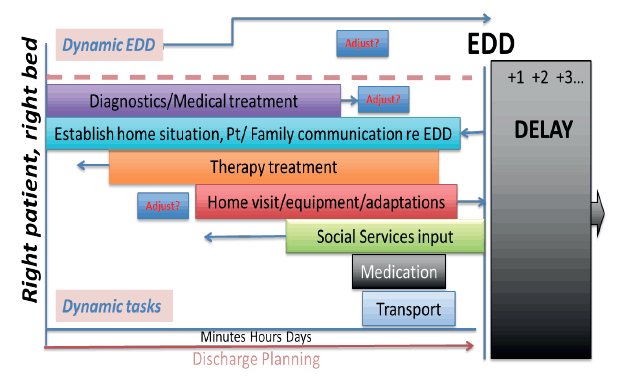Patient care - daily dynamic discharge approach: guidance
Guidance on the daily dynamic discharge approach to improving the timeliness and quality of patient care by planning and synchronising the day's activities.
Creating a Plan
1. Dynamic MDT Planning
The Multi-Disciplinary Team get together within 12 hours of a patient's admission and develop an understanding of the component parts of a patient's discharge plan - what treatment is required, with what - and for how long. They also consider what other things need to be done in parallel with the clinical treatment, in order for each patient to be discharged safely onto the next appropriate area of care.
Identifying what are the dependant tasks and agreeing when they each need to start (and finish) to ensure the patient can be discharged without delay is essential.
The term 'dynamic' relates to the movable nature of the estimated discharge date, and the dependant tasks relative to the patient's recovery rate.

2s. Setting and Reviewing an Estimated Date of Discharge (EDD)
The estimated date of discharge ( EDD) is the date when the MDT believes the patient can be safely discharged from the acute hospital setting. This may be to home or another place of care.
The key to setting an accurate EDD is:
1. a clinical process to estimate and document a date of predicted medical fitness (i.e. when the patient no longer needs medical treatment in hospital)
2. followed by a communication process to document an estimated date of discharge based on the holistic/ MDT view
3. changed to reflect the most recent view of the patient's recovery rate (is this still the date we expect this patient to be well enough to leave our care?)
Figure 1 below shows an example from a hospital site of the process established to ensure consistency in setting an EDD across all wards to ensure full compliance with the Daily Dynamic Discharge approach.
Figure 1: an example from an NHSScotland Hospital site
| Guidance |
|
|---|---|
| Electives |
|
| Emergencies |
|
| Admission |
|
| Setting the EDD |
|
| Reviewing the EDD |
|
| On the ward round |
|
| Communication with the patient |
|
3. Effective Ward Rounds
A fundamental part of the approach is clarity around the plan for the patient's clinical treatment to ensure that all other tasks are able to commence timeously and be aligned with the date the patient is medically fit for discharge.
To ensure that the EDD is truly dynamic and reflective of the patient's treatment and recovery, the treatment plan must be clearly communicated to the multi-disciplinary team involved.
Ensuring that ward rounds are effective and that the Senior Decision Maker's treatment plan has been clearly articulated is essential to ensuring that all elements are in place for that patients care.
It is useful to test this effectiveness and identify any areas for improvement. A proforma template is recommended to be completed during discussions for each patient; ensuring the following questions around the discharge plan are answered.
- What is it we are treating (diagnosis)?
- What treatment are we providing?
- For what period of time?
- What is the remaining duration of that today?
- What other things need to be in place for discharge?
- Does the EDD need to be changed?
- Does this patient need to be seen again by a consultant before discharge (suitable for criteria led discharge)?
This process of using a proforma ensures each patient's treatment plan is consistently considered and reviewed as appropriate.
Contact
Email: Unscheduled Care Team
There is a problem
Thanks for your feedback